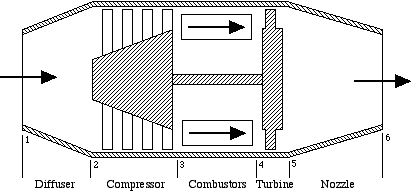
There are many different forms and modifications of aircraft gas turbine engines, and in this course we discuss two variants - the ideal turbojet engine, and the gas turbine engine for usage in helicopters.
The ideal turbojet engine shown schematically in the above figure comprises the series connection of five components - diffuser, compressor, combustor, turbine, and nozzle. The analysis of the complete system, is best done in terms of the h-s (enthalpy-entropy) diagram, which we will develop in class. Throughout the system we assume that the fluid is pure air, and the combustors are considered to be constant-pressure heat-addition devices. Notice that the sole purpose of the turbine is to drive the compressor, the nozzle providing the final kinetic energy increase to drive the aircraft.
The gas turbine engine for usage in helicopters is shown below:
In this case we see that there is no diffuser or nozzle, and that the turbine section has been replaced by two independent turbines - a "gas generator", or "gassifier" turbine to drive the compressor, and an output turbine to drive the helicopter blades. A typical gas turbine engine of this type is the General Electric T700 engine shown below, which is used in the Army Black Hawk helicopter.


The Industrial Technology department retains a fullsize cutaway model of a T700 engine, which is the basis of the following solved problem.
Solved Problem 6.11 - The General Electric T700 Gas Turbine Engine
Problem 6.12 - Actual Power Output of the T700 Gas Turbine Engine
Solved Problem 6.13 - T700 Proposed Turbojet Conversion
Problem 6.14 - An Aircraft Gas Generator Turbine
______________________________________________________________________________________
![]()
Engineering Thermodynamics by Israel
Urieli is licensed under a Creative
Commons Attribution-Noncommercial-Share Alike 3.0 United States
License